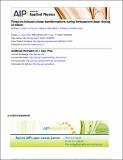Pressure-induced phase transformations during femtosecond-laser doping of silicon
Author(s)
Smith, Matthew J.; Lin, Yu-Ting; Sher, Meng-Ju; Winkler, Mark T.; Mazur, Eric; Gradecak, Silvija; ... Show more Show less
DownloadGradecak_Pressure-induced phase.pdf (1.772Mb)
PUBLISHER_POLICY
Publisher Policy
Article is made available in accordance with the publisher's policy and may be subject to US copyright law. Please refer to the publisher's site for terms of use.
Terms of use
Metadata
Show full item recordAbstract
Silicon hyperdoped with chalcogens via femtosecond-laser irradiation exhibits unique near-unity sub-bandgap absorptance extending into the infrared region. The intense light-matter interactions that occur during femtosecond-laser doping produce pressure waves sufficient to induce phase transformations in silicon, resulting in the formation of metastable polymorphic phases, but their exact formation mechanism and influence on the doping process are still unknown. We report direct observations of these phases, describe their formation and distribution, and consider their potential impact on sub-bandgap absorptance. Specifically, the transformation from diamond cubic Si-I to pressure-induced polymorphic crystal structures (amorphous Si, Si-XII, and Si-III) during femtosecond-laser irradiation was investigated using scanning electron microscopy, Raman spectroscopy, and transmission electron microscopy. Amorphous Si, Si-XII, and Si-III were found to form in femtosecond-laser doped silicon regardless of the presence of a gaseous or thin-film dopant precursor. The rate of pressure loading and unloading induced by femtosecond-laser irradiation kinetically limits the formation of pressure-induced phases, producing regions of amorphous Si 20 to 200 nm in size and nanocrystals of Si-XII and Si-III. The surface texturing that occurs during femtosecond-laser irradiation produces inhomogeneous pressure distributions across the surface and causes delayed development of high-pressure silicon polymorphs over many laser pulses. Finally, we find that the polymorph phases disappear during annealing more rapidly than the sub-bandgap absorptance decreases, enabling us to decouple these two processes through post-treatment annealing.
Date issued
2011-09Department
Massachusetts Institute of Technology. Department of Materials Science and EngineeringJournal
Journal of Applied Physics
Publisher
American Institute of Physics (AIP)
Citation
Smith, Matthew J., Yu-Ting Lin, Meng-Ju Sher, Mark T. Winkler, Eric Mazur, and Silvija Gradečak. “Pressure-induced phase transformations during femtosecond-laser doping of silicon.” Journal of Applied Physics 110, no. 5 (2011): 053524. © 2011 American Institute of Physics
Version: Final published version
ISSN
00218979
1089-7550